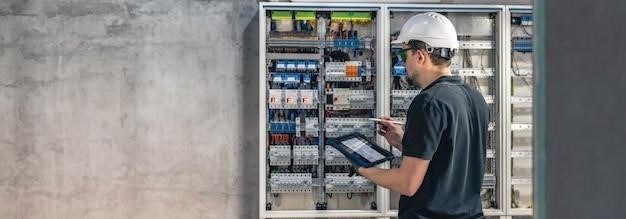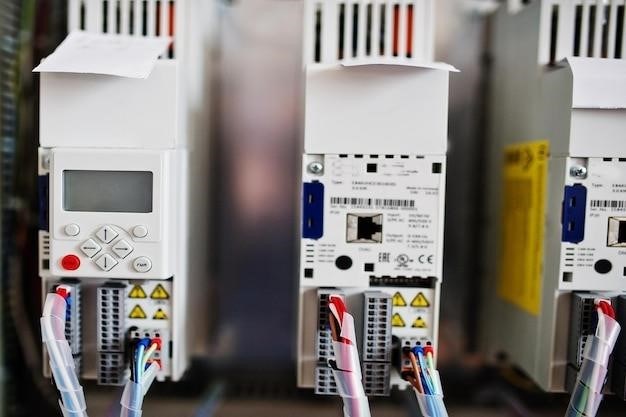Hebel PowerPanel Installation⁚ A Comprehensive Guide
This guide provides a step-by-step approach to installing Hebel PowerPanel systems, covering preparations, panel placement, securing, finishing, essential tools, safety, troubleshooting, and post-installation checks. Consult the Hebel technical manuals for detailed specifications and best practices. Remember to always prioritize safety and adhere to local building codes.
Understanding Hebel PowerPanel Systems
Hebel PowerPanel systems utilize lightweight, steel-reinforced autoclaved aerated concrete (AAC) panels for efficient and robust wall construction. These panels offer superior thermal and acoustic performance compared to traditional masonry, contributing to energy-efficient buildings and comfortable living spaces. The system’s prefabricated nature significantly reduces on-site construction time and labor costs. PowerPanel is available in various sizes (PowerPanel50 and PowerPanelXL) to suit diverse project needs, from residential to high-rise applications. The panels’ inherent strength and durability, combined with the integrated steel reinforcement, ensure structural integrity and longevity. The anti-corrosion coating on the steel further enhances the system’s lifespan and resistance to environmental factors. The ease of installation makes Hebel PowerPanel a popular choice for both internal and external walls.
PowerPanel Types and Sizes⁚ PowerPanel50 and PowerPanelXL
Hebel offers two primary PowerPanel variations⁚ PowerPanel50 and PowerPanelXL. PowerPanel50, a 50mm thick panel, is ideal for various applications, including internal walls and intertenancy walls in low-rise multi-residential buildings. Its versatility and manageable size make it suitable for smaller projects or areas with limited space. PowerPanelXL, a significantly thicker 75mm panel, provides enhanced structural performance and is particularly well-suited for external walls in two-story dwellings and high-rise construction. Both types incorporate steel reinforcement for added strength and durability, encased within the AAC core for superior protection against corrosion. The panels are available in standard lengths, often 2.4m, 2.7m, and 3m, but custom lengths can be ordered to minimize waste and optimize project efficiency. Choosing between PowerPanel50 and PowerPanelXL depends primarily on the project’s specific structural requirements and the desired level of thermal and acoustic insulation.
Pre-Installation Preparations⁚ Foundation and Site Assessment
Before commencing Hebel PowerPanel installation, a thorough site assessment and foundation verification are crucial. Ensure the foundation meets all local building code requirements for load-bearing capacity and levelness. Any deviations from the required levelness must be addressed before proceeding to avoid structural issues later. Check foundation dimensions to ensure they accurately match the planned wall dimensions. Verify the vertical reinforcement (spacing) in the foundation, especially if using concrete, to confirm its suitability for supporting the PowerPanel system. Existing structures should be inspected for stability and any potential conflicts with the new wall installation. The site should also be cleared of any obstructions that might hinder the installation process. Proper planning and preparation at this stage will prevent delays and potential problems during the main installation phase. Detailed plans and specifications are essential for a smooth installation.
Step-by-Step Installation Process⁚ Panel Placement and Fixing

Begin by carefully positioning the first Hebel PowerPanel according to your design plans, ensuring accurate alignment and verticality. Use a level to confirm precise placement before applying adhesive. Apply a consistent bead of Hebel adhesive to the back of the panel, following manufacturer recommendations for coverage. For larger panels or those in high-wind areas, additional support might be necessary during initial fixing. Once the adhesive is in place, firmly press the panel against the foundation or framing, ensuring complete contact to maximize bond strength. Use spacers to maintain uniform joints and check alignment regularly throughout the process. For subsequent panels, ensure the tongue-and-groove system (if applicable) engages correctly. Once a section is complete, allow sufficient curing time for the adhesive before moving to the next section. Always follow the manufacturer’s instructions for adhesive type and application for optimal performance and longevity of the wall system.
Securing and Finishing⁚ Adhesive, Mortar, and Gap Filling
After panel placement, carefully inspect all joints for gaps. Small gaps can be filled with Hebel adhesive, ensuring a smooth, even surface. For larger gaps or uneven areas, use a suitable mortar mix, applying it neatly and evenly to avoid excess material. Allow the adhesive and mortar to cure completely according to the manufacturer’s instructions before proceeding to the next steps. Remove any excess adhesive or mortar that might protrude from the joints using a scraper or trowel. Maintaining clean joints contributes to the overall aesthetic appeal and structural integrity of the wall. Ensure that the filling materials are compatible with the Hebel PowerPanels and the intended final finish. If rendering or cladding is planned, prepare the surface according to the manufacturer’s recommendations for optimal adhesion and a long-lasting result. Regularly inspect your work for any inconsistencies or imperfections during and after the filling process.
Essential Tools and Equipment for a Smooth Installation
Efficient Hebel PowerPanel installation requires specific tools. A circular saw with a diamond-tipped blade is crucial for on-site cutting, ensuring precise panel sizing. For accurate measurements and marking, utilize a measuring tape, level, and marking pencils. To ensure secure fixing, you’ll need appropriate adhesive and mortar, along with trowels for even application. A lifting device, such as a hoist or crane, might be necessary for handling larger panels, improving safety and efficiency. Personal protective equipment (PPE), including safety glasses, gloves, and sturdy work boots, is essential for protecting against potential hazards. Additional tools might include a hammer, screwdrivers (if using screws), and a sealant gun for filling any remaining gaps. Having all necessary tools readily available streamlines the installation process, minimizing delays and ensuring a professional finish. Refer to the Hebel PowerPanel installation guide for a detailed list of recommended tools and equipment.
Safety Precautions and Best Practices During Installation
Prioritize safety throughout the Hebel PowerPanel installation. Always wear appropriate personal protective equipment (PPE), including safety glasses, gloves, and sturdy footwear, to protect against potential hazards. When handling panels, use appropriate lifting equipment to avoid injuries; two people are recommended for larger panels. Ensure the work area is well-lit and free from obstructions to prevent accidents. Follow the manufacturer’s instructions precisely to ensure correct panel placement and fixing. If working at heights, use appropriate fall protection measures. Regularly inspect tools and equipment for damage or wear and tear. Be mindful of electrical wiring and plumbing during installation. Store materials properly to prevent damage or theft. Maintain a clean and organized worksite to minimize the risk of trips and falls. Report any injuries or incidents immediately and follow proper reporting procedures. Adherence to these best practices ensures a safe and efficient installation process, minimizing risks and ensuring a quality outcome.
Troubleshooting Common Issues During Installation

Uneven surfaces can cause installation difficulties. Address this by ensuring a level foundation before starting. Incorrect panel alignment may lead to gaps; carefully check alignment before fixing. Difficulty cutting panels may be due to dull blades; use a sharp diamond-tipped blade for clean cuts. Insufficient adhesive or mortar can compromise structural integrity; use the recommended amount for secure fixing. Cracks appearing after installation might indicate improper fixing or inadequate support; reinforce weak points with additional adhesive or structural supports. If panels become damaged, assess the extent of the damage. Minor damage may be repairable, but severely damaged panels need replacement. Consult the Hebel technical manual for guidance. Remember that working with sharp tools requires caution and proper handling. Always follow safety precautions and use appropriate PPE. If problems persist, contact Hebel technical support for expert advice. Accurate measurements and careful planning are key to a smooth installation process.
Post-Installation Inspection and Maintenance
Following Hebel PowerPanel installation, a thorough inspection is crucial. Verify panel alignment, ensuring straightness and proper fitting. Check for any visible gaps or cracks, addressing them with appropriate sealant if needed. Inspect the adhesive or mortar joints, ensuring complete coverage and secure bonding. Examine the overall structural integrity of the wall, paying attention to any signs of weakness or instability. Assess the finished surface for any imperfections or damage. Regular maintenance is minimal but important for longevity. Periodically inspect for any signs of damage, such as cracks or loose panels. Address any minor issues promptly to prevent larger problems. Protect the panels from harsh weather conditions, especially during extended periods of extreme temperatures or heavy rainfall. Avoid using abrasive cleaning materials that could scratch or damage the surface. A simple rinse with water and a soft brush is usually sufficient for cleaning. For more detailed maintenance advice, refer to the comprehensive Hebel PowerPanel maintenance guidelines available in the technical manual or on the Hebel website.
